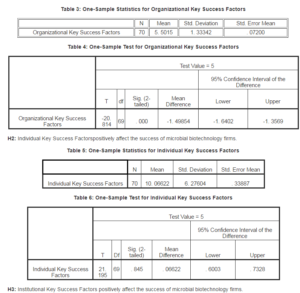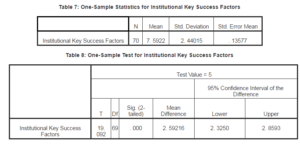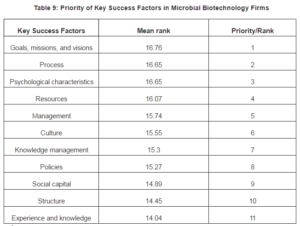Introduction
At the forefront of researchers’ interest in the 21st century, the biotechnology industry is a dynamic and different industry (Cantley, 2004). The industry is made up of specializedmicrobial biotechnology firms as well as firms employing the technologies, applications, and products in several industries including pharmaceuticals, agriculture, chemicals, computer, medical device, environmental industries, etc. Recent brilliant achievements in biotechnology include the completion of the DNA sequencing of the human genome, and the subsequent availability of this blueprint for public use. The impact of microbial biotechnology is most significant in human healthcare, but spreads beyond to include animal health, industrial and environmental applications, and criminology. Innovations include breakthroughs in regenerative medicine, cloning, etc. The intersection of microbial biotechnology and other high-tech and traditional industries has even led to the development of specialized industry sub-sectors based on new hybrid technologies (Hall and Bagchi-Sen, 2007).
Therefore, in one hand, microbial biotechnology firms are of paramount importance for policy makers in different countries all around the world (e.g. Sukara and Slamet-Loedin, 2000; Vandamme, 2009; Nigam and Pandey, 2009); On the other hand, the topic is a critical one in developing countries which strive to win the game in the cutting edge of technology (e.g. Sukara and Slamet-Loedin, 2000). In this regard, elaborating the success factors in such countries is in the center of attention for the officials who are looking for gaining a competitive advantage over their rivalries. Thus, in this research we focus on Iranian microbial biotechnology firms to identify and prioritize their success factors. In this way, findings of this research will help Iranian microbial biotechnology firms in developing and improving their performance, as the main focus is on inter-organizational factors. Moreover, it should be noted that this research is among the first efforts to look at microbial biotechnology firms as highly profitable ventures and not just as typical scientific institutions. To do so, we firstly review the theoretical background. Then, we discuss the methodological issues and we highlight the findings and the paper concludes.
Theoretical Background
For over 30 years, modern microbial biotechnology with its progressing scientific breakthroughs has been under public inspection and political discussion around the world (Cantley, 2004). Though there has been some biotechnological research in Iran during the past 20 years, valuable research in the field of modern microbial biotechnology began only after the establishment of the organizations such as Agricultural Biotechnology Research Institute of Iran1 in 19982. Iran started using modern microbial biotechnology one or two decades after the developed countries, that is, from the mid-1990s, but only in the past five years has this technology been seriously considered. The government’s investments in microbial biotechnology together with the efforts of researchers and experts led to several developments. It is likely that in the upcoming years a significant increase in biotechnological products will be witnessed. Despite the efforts of researchers, Iran still has no share of the increasing trade of biotechnological products and is only an importer of some of these products. Indeed, without exact statistical reports, the amount of imported products cannot be determined. According to the capabilities and facilities for microbial biotechnology and the needs of the country, microbial biotechnology plans are being prepared (SeifiAbdolabad, 2007; Nasr Esfahani, 2007).
| 1 One of the most advanced agricultural biotechnology research center in the country.
2 While Pasteur Institute of Iran and Razi Institute both have more than 70 years’ of experience in conventional biotechnology. |
Based on the scientific research and reports, microbial biotechnology techniques can solve several potential problems. But what is the opinion of ordinary people about these types of changes? Just a decade ago, the awareness of microbial biotechnology was very low in most countries. For example, surveys indicated that only about one-third of consumers in the USA have heard or read much about microbial biotechnology. In 1995, similar results obtained from Japan, France and UK (Hoban, 1997).Although during recent years, increased media coverage led to a significantincrease in public awareness but not public knowledge (Sheikhha et al., 2006).
Media coverage is the main source of people’s information on microbial biotechnology and has significant influence on consumers’ attitude. Therefore the media must be used by scientific community to reach the public with precise information about microbial biotechnology. For instance, the positive media coverage in USA helped the relatively high levels of acceptance of microbial biotechnology in that country (Gaskell et al., 1999). In America and Australia, genetically modified foods are adopted in their agriculture policy while in almost all the European countries public attitudes toward microbial biotechnology have been regarded as negative (Pardo et al., 2002). The ambition across Europe to avoid genetically modified foods has led to an increase of demand for such foods. Meanwhile some firms announce that they are going to produce such products because they do not want to lose their market as a result of the negative opinion of their consumers about these products (Sheikhha et al., 2006).
In a nutshell, in Iran, this subject has not been considered as a critical focus of discussion. There are some groups that are against many new technologies, pleading that these foods are hazardous to environment. On the other hand, the other groups are in favor of such productswhoargue that there is not any evidence of damage to health and environment. The risks of using these technologies against their benefits must be weighted either by society as a whole or by the scientific community. However, there are worldwide discussions about how to assess and to manage possible risks of such products and on the potential of biotechnology to improve global utility (McCullum et al., 2003).
Methodology
A mixed research design was selected, which started from a qualitative approach to identify the inter-organizational success factors, and continued by a survey to prioritize those factors. In the first stage, open and axial coding of statements was used, and in the second stage, descriptive and analytical statistics were used to prioritize the factors. According to formula (1), a total of 67 respondents were needed. However, a total of 70 respondents (29 female and 41 male) contributed to this survey.

The respondents were randomly chosen from experts in 30 high-tech biotechnology firms, regarding to the gender, occupation, etc. The respondents were originally from different parts of country coming to this field for continuing in biotechnology industry. The median range of experience the students was 10 to 15 years (Table 1). Table 2 shows the level of education of respondents.

A questionnaire was designed to evaluate their knowledge and perceptions about inter-organizational success factors of biotechnology firms. The questionnaire was developed by expert opinions and was validated on a focus group. It starts with a brief statement about the nature of biotechnology to give elementary information to the participants follows by 45 multiple choice questions with a nine-point Likert scale. The data were compared by SPSS version 20.0. The level of p-value <0.05 was considered as significant.
Findings and Results
In the first phases on the research, a qualitative approach was used to investigate the findings of the evidences found in the literature. Then, based on the evidences in the literature, and the findings of our interviews the following conceptual framework is proposed (Figure 1). There are three main groups of factors, which are:
Organizational Key Success Factors (OKSFs)
These factors include those elements that directly influence the success of microbial biotechnology firms. As mentioned earlier, the main focus of this research is on identification of these elements. Among the organizational factors the followings were of paramount importance:
* Resources: financial resources, IP protection, experienced human resources, etc.
* Structure: hierarchy, being private or public, technology based structure, etc.
* Management: supportive management, management commitment, industrial experience of the managers, cost management, product quality management, etc.
* Process: product development, marketing strategies, customer relationship management, etc.
* Knowledge Management: Extent of knowledge creation and dissemination, and extent to which knowledge is restored and applied in the organization.
Institutional Key Success Factors (IKSF1s)
These factors are playing the role of facilitation to pave the way for the microbial biotechnology firms. It goes without saying that these elements are different in nature; as these would better exist to ensure the realization of other factors. The main Institutional factors were:
* Culture: team work culture, entrepreneurial culture, and motivating culture for business.
* Policies: The most important policies were those which concentrate on human resources, and compensation policies. At the national level, these policies might cover legislative laws and procedures.
* Social Capital: customers’ reliability to the firm and vice versa, the extent to which organizational researchers have access to governmental bodies, and the brand which is empowered based on the name of the biotechnological experts.
* Goals, Missions, and Visions: the degree to which the vision, mission, and goals are accepted by the experts, and dependency of the firms on the acts of ministries and other national bodies.
Individual Key success Factors (IKSF2s)
Individuals are considered as the main role players in any organizational arrangement. Microbial biotechnology firms also need to pay considerable attention to them, and the factors which might affect them. In order to guarantee the success of any microbial biotechnology firm, the following factors were identified in our research:
* Psychological Characteristics: tolerance of ambiguity, tolerance of failure, self confidence, and risk taking.
* Experience and Knowledge: knowledge of the main team members, prior knowledge of establishing and running such a business, ability to manage and lead people, etc.
* Interpersonal Networks: As these industries are highly dependent on the knowledge and experience of their human resources, interpersonal networks could bring success into their firms. Therefore, good interpersonal networks make a firm more successful in its supply chain management; and thus lead in its success.
Figure 1: Conceptual Framework for Key Success Factors in Microbial Biotechnology Firms

Afterwards, in the quantitative phase, we proposed three main hypotheses, which are as follows:
H1: Organizational Key Success Factors positively affect the success of biotechnologyfirms.


The test statistic for the t-test on one population mean is derived under the assumption thatthe sample was randomly chosen from a normal population and that the population standarddeviation is unknown and must be estimated from the sample. As it is evident from the Tables above, all the factors are significantly influencing the success of microbial biotechnology firms. Moreover, for the purpose of prioritizing the key success factors, Friedman’s test was used. Based on the findings of this test, Table 7 shows the priority of each factor.

Conclusion
As discussed earlier, microbial biotechnology is one of the three broad technologies that emerged in the post-war period, together with information technologies and advanced materials. Microbial biotechnology has several distinguishing traits that differentiate it from the two others. Most important, microbial biotechnology has emerged from university research, and thousands of firms have been created in the last 20 years in all developed countries. Moreover, dedicated microbial biotechnology firms have competed, and cooperated, with established pharmaceutical and chemical firms. In this competition, some of the firms achieved competitive advantage over others and were more successful in running and developing their business. Therefore, the importance of identification and prioritization of their success factors became more highlighted. Then, the questions posed in this study are: what are the main inter-organizational success factors in Iranian microbial biotechnology firms? (Identification),and which factors are more important? (Prioritization).According to the findings of our research, three factors and their elements were identified: Organizational Key Success Factors (Resources, Structure, Management, Process, and Knowledge management), Institutional Key Success Factors (Culture,Policies,Social capital, andGoals, missions, and visions), and Individual Key success Factors (Psychological characteristics, Experience and knowledge, and Interpersonal networks). In the second phase, the priorities were calculated and determined. Based on our findings, authors suggest that future researchers could concentrate on external elements and also their role in the success of microbial biotechnology firms.
References
Abdolabad, A. R. S. (2007). “Agricultural Biotechnology Status in the Islamic Republic of Iran: Progress, Products, Limitations, and Future,” Business Potential for Agricultural Biotechnology, 6, 116-119.
Publisher – Google Scholar
Cantley, M. (2004). “How Should Public Policy Respond to the Challenges of Modern Biotechnology?,” Current Opinions in Biotechnology, 15, 258-263.
Publisher – Google Scholar
Esfahani, E. N. (2007). “Status of Agricultural Biotechnology in the Islamic Republic of Iran,” Business Potential for Agricultural Biotechnology, 6, 120-124.
Publisher – Google Scholar
Gaskell, G., Bauer, M. W., Durant, J. & Allum, N. C. (1999). “Worlds Apart? The Reception of Genetically Modified Foods in Europe and the U.S.,” Science, 16, 384-387.
Publisher – Google Scholar – British Library Direct
Hall, L. A. & Bagchi-Sen, S. (2007). “An Analysis of Firm-Level Innovation Strategies in the US Biotechnology Industry,”Technovation, 27(1), 4-14.
Publisher – Google Scholar
Hoban, T. J. (1997). “Consumer Acceptance of Biotechnology: An International Perspective,” Nature Biotechnology, 15, 232-234.
Publisher – Google Scholar – British Library Direct
McCullum, C., Benbrook, C., Knowles, L., Roberts, S. & Schryver, T. (2003). “Application of Modern Biotechnology to Food and Agriculture: Food Systems Perspective,” Journal of Nutrition Education and Behavior, 35(6), 319-332.
Publisher – Google Scholar – British Library Direct
Nigam, P. S. N. & Pandey, A. (2009). Biotechnology for Agro-Industrial Residues Utilisation: Utilisation of Agro-Residues,Springer.
Publisher – Google Scholar
Pardo, R., Midden, C. & Miller, J. D. (2002). “Attitudes toward Biotechnology in the European Union,” Journal of Biotechnology, 98(1), 9-24.
Publisher – Google Scholar
Sheikhha, M. H., Kalantar, S. M., Vahidi, A. R. & Faghihi, M. (2006). “Public Knowledge and Perceptions of Biotechnology and Genetically Modified Organisms in Iran,” Iranian Journal of Biotechnology, 4(2).
Publisher – Google Scholar
Sukara, E. & Slamet-Loedin, L. H. (2000). “Agricultural Biotechnology in Indonesia,” In Proceedings of the Regional Conference on Agri-Biotech (pp. 1-167).
Publisher – Google Scholar
Vandamme, E. J. (2009). “Agro-Industrial Residue Utilization for Industrial Biotechnology Products,” Biotechnology for Agro-Industrial Residues Utilisation, 3-11.
Publisher – Google Scholar








